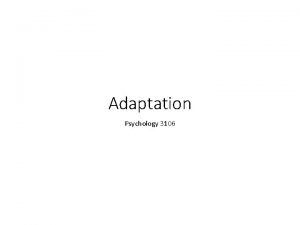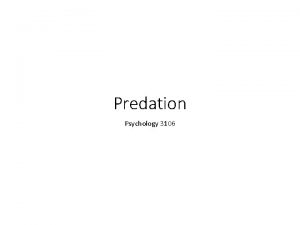Communication Psychology 3106 Introduction Animals spend a lot












- Slides: 12

Communication Psychology 3106

Introduction • Animals spend a lot of time communicating • Defense • Mating • Food sources • To say communication has occurred we need a sender and a receiver • As usual, we can look at evolutionary change, or adaptive value (or both of course)

You can dance if you want to…. • Dance language of the honeybees • Function is to communicate location of food sources to hive members • Hive members then can interpret the dance • They then go out in the right direction and distance (or just right direction, depends) and find the food

The Round Dance • Used only if food source is < 50 m away • Number of circuits in a given time tell how far away food source is • No direction info is given with the round dance

The Waggle Dance • If food source is > 50 m away • Redundant sources of distance info • • Number of circuits Number of waggles Number of sound bursts All proportional to distance • Angle of straight line portion of dance gives compass direction! • Up is where the sun is in the sky

• If you don’t think this is cool…. . • If they are forced to dance in the open air, they will actually use the sun rather than ‘up means sun’

Reconstructing the evolution of the honeybee dance • Lindauer’s work • All honeybees dance • All other Apids dance, but Apis Florea uses a sort of open air ‘dance floor’

And the story continues… • Some Trigona species just get exited and hum a lot • Giving out food in the process actually • Other Trigona species leave a scent mark as well • Melipona give out pulses of sound • Sort of leads ‘em out

Adaptive Value • The Hive works together anyway, so its best to get to food quickly, by getting others involved • The hive works together, but for very specific reasons, and it is not altruism, more on that when we get there • Don’t have to waste time leading others out, risk predation etc • Costs? • Other animals could interpret the signal • Very unlikely in the bee example

Sometimes other animals get the signal…. . • Tungura Frogs • Females like the ‘whine chuck’ call • Everybody whine chuck tonight…. • (Drives the babes wild) • But, umm, bats like it too, and bats eat frogs! • When they are alone, males only whine, when they are with other males, they ‘whine chuck’

You might just get what you wish for, so be careful. . • Male European toads call • Biggest females respond • Ummm errr, well, ummm, it can get ugly, lets’ just say that….

Conclusions • Animals communicate alll the time • Olfactory • Calls • Various other signals • Others can learn to pick up on the signals • Nothing like language though! • Humans win humans win!!!
 Present perfect and past continuous
Present perfect and past continuous Put in much many little few
Put in much many little few Diferencia entre a lot of y a lot
Diferencia entre a lot of y a lot The lot-for-lot (lfl) rule
The lot-for-lot (lfl) rule Https://a-z-animals.com/animals/
Https://a-z-animals.com/animals/ Consumer decomposer producer
Consumer decomposer producer Detritus food chain
Detritus food chain Carnivore
Carnivore Chapter 24 introduction to animals worksheet answers
Chapter 24 introduction to animals worksheet answers How to tell wild animals pictures
How to tell wild animals pictures Introduction to animals section 1 animal characteristics
Introduction to animals section 1 animal characteristics Positive psychology ap psychology definition
Positive psychology ap psychology definition Chapter 13 social psychology
Chapter 13 social psychology























